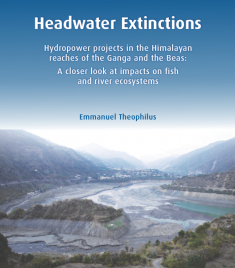Headwater Extinctions: Hydropower Be the Death of Fish
“You can either be pro-environment or pro-development” is a futile binary statement that government officials often aim at people like me who work for environmental NGOs in India. They don’t understand integrated resources planning, soft-engineering or smart infrastructure. It’s barrages, dredged waterways and large hydropower dams, or, your river with all the fish in the world. One or the other, mate.
On more than the one occasion I’ve been offered the platitude, “You can’t have your cake, and eat it too”. To make matters worse, there’s a prevailing sense that arguments arising from an environmental point of view – be it calls to save the wetlands, biodiversity, fish and other life forms, riparian vegetation, etc. – are unlikely to go far with the present government. It’s so called “development” – interchangeable with big infrastructure – at all costs. But the double speak is apparent. The incumbent government has made tall claims to rejuvenate rivers, particularly the Ganga, yet refuses to back down or re-work its plans for hundreds of dams in the upper reaches and several more barrages in the plains that will snap the longitudinal connectivity. What happens to biota, sediment transport, and nutrient flow, much less water flows, all of which are essential for fish and riverine ecosystems, seems to be of little concern.
It is in light of this that the South Asia Network for Dams, Rivers and People (SANDRP) commissioned and recently published a critical report called Headwater Extinctions that deals with the impact of hydropower projects in the Beas River basin and the headwater basins of the Ganga, i.e. the Alaknanda and Bhagirathi. While social impacts of dams, including displacement and irregular downstream flows, along with other impacts to people during construction are well known, there are few credible studies that have looked at river ecosystems as a whole and in particular the impact of hydro projects on fish and aquatic biodiversity.
Emmanuel Theophilus working with Himal Prakriti in Uttarakhand wrote the report. He is described as an avid mountaineer, storyteller and ecologist. Theo, as his peers refer to the author, has written the report partly as a travel narrative and partly in academic research style, including references and footnotes. He recorded conversations to document impacts of hydropower on fish with everyone from native octogenarians to fish biologists. There is plenty of compelling evidence, anecdotal and scientific, that these rivers had plentiful fish and teeming biodiversity up until hydropower dam projects were built and commissioned. Sher Singh, 80 years old of Jakhni village talks of abundant snow trout in the Nandakini, a tributary of the Ganga headwater River Alaknanda up until 2002. All the villages along the river depended on fish for food, but now go without it after the commissioning of the Rajwakti hydroelectric project.
As per a recent blog published by SANDRP: “We hope Headwater Extinctions provides sufficient material and compelling reasons to overhaul the way impacts of hydropower projects on fisheries and aquatic biodiversity are treated by Environmental Impact Assessments, Environmental Management Plans and government committees”.
Download the full report, here.



